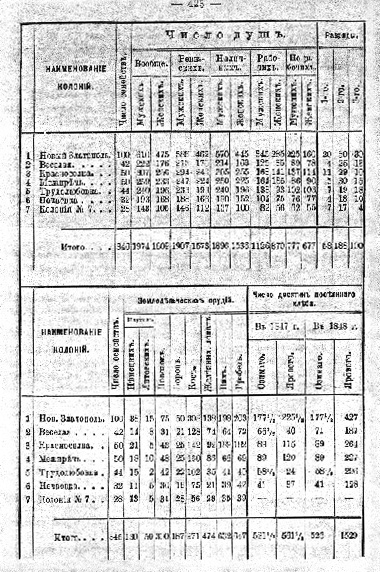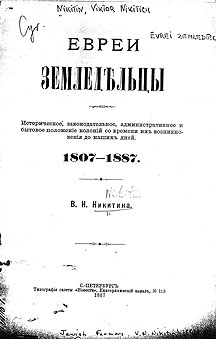| "Jewish Farmers: Historical.
Legislative. Administrative, and Conditions of Daily Life in the Colonies
from their Origin to the Present. 1807_1887" (Translated by Patricia A. Eames, Editor) All Rights Reserved. First printed in the RAGAS Newsletter of Spring 1999 Volume V, Number 1 Reprinted with the permission. May not be reproduced without permission. |
|
|
V.N. Nikitin 's monograph, "Jewish Farmers: Historical. Legislative. Administrative, and Conditions of Daily Life in the Colonies from their Origin to the Present. 1807-1887" appeared in St Petersburg in1887.
It rarely appears now in current bibliographic references. It is evident that not one of the contemporary Ukrainian researchers who were authors of a collection of articles ("The Jewish Population in Greater Ukraine: Records And Documents", (Vip. L Zaporothyo, 1994) about Jewish farm colonization in the Northern Black Sea area ever referred to this monograph, in reality, it is the basic work for this subject both for the pre-Revolutionary period and after 1917. In fact, only S-Ya. Borovomu later succeeded in writing a scholarly work on a similar level, "Jewish Farm Colonization in Old Russia: Politics. Ideology, Economics, and Daily Life According to Archival Materials', M.,1928.
Incidentally, this treatment by V.N. Nikitin of the Jewish problem was not without design; he was a baptized Jew, therefore he was familiar with the history of his people. His work is based on records of the ministries of Internal Affairs, Finance and State properties. He describes in meticulous detail the history of the Jewish colonization of the Northern black Sea area for 80 years with an emphasis on the administrative and economic sides of colony life. Since this work by V. N. Nikitin is based on archival materials from various governmental departments, portions of which have not been preserved, its value becomes even greater. He did not establish any genealogical goals, however he could not, while examining in detail the course of Jewish colonization of the Novorossian region, avoid this aspect, nor ignore the details of daily life in the Jewish settlements. Information concerning individual Novorossian Jewish farmers is literally scattered through most of the book. Our task will be to note only the questions which relate to specific individuals from among all of the colonists. The primary sources of genealogical information for the author were formal applications by Jews regarding various requests, materials from the periodic censuses of the Jewish colonies, compilations by the Guardianship Office, complaints of me colonists. Basically they cover the initial period of Jewish farm colonization, 1807 - 1818 (and in separate cases - 1826, 1845, 1859 and 1863). Of particular interest is information concerning the very first Jews who led the resettlement process for their colleagues from the western provinces in southern Russia. In 1806, for the first time in the history of Jewish colonization, Nochim Finkelshtein, and Israel Lentport, Jews from the Cherikov District, Mogilev Province, applied to the Mogilev governor, M.M. Bakunin requesting the settlement of just 36 families (198 men) in the Novorossian region; this was reported to the Minister of Internal Affairs, Count V.P. Kochubeyu (p.8). After submitting their application to the local administration, the Cherikov Jewish petty- bourgeoisie sent trustee Finkelshtein to Saint Petersburg, where he applied first to me Ekspeditdiu [1r: Dispatch?] Office of the State Administration, and then repeated the application to Kochubeyu. The Count replied by letter to the Jewish agent giving his consent and agreeing to send Jewish representatives to Novorossia for the selection of farm plots for settlement. Shortly after, two representatives of the Cherikov Jews, Finkelshtein and Liberman, traveled to the Cherson Province and chose a section of 6.5 thousand dessiatines [tr: a dessiatine equals 2.7 acres} on the left bank of the Ingul River in the Cherson District (p. 12). Several months later trustee Safranchik went to V.P.Kochubeyu with identical applications for 52 families (96 men) from the Mstislav District of the Mogilev Province (p. 11). In this same year the Novorossian Guardianship Office received an application, which Safranchik and Fal'bishovich submitted for nearly 100 families of the Mogilev Province, concerning preparatory arrangements for the reception of the settlers (arranging housing, purchasing draft animals, seed and agricultural tools, and rendering monetary aid). In 1807 Finkelshtein brought 43 families (445 men) to Elisabetgrad and areas farther out on the steppe, where they were placed in hurriedly constructed housing (p. 15). Jews of Starodyb, Novograd-Volin, Surazh, Pogar, Nezhin, Sosnitsa, Poltava and Chernigov districts of Chernigov Province (91 families) formed groups which lived adjacent to those settled on the free land. A group of 60 Grodno families accompanied the Jewish trustee Densburg to Novorossia (p.20). Later on, Finkelshstein, the mayor of the Efengar colony, was me leader in a successful harvest: in 1810, the former trustee harvested 30 quarters out of a common harvest of 103 quarters of grain, that is, about a third (p. 32, 52, 70). This was noted in particular when commission officials inspected the colony in 1812. The monograph also includes information about rabbis living in the Cherson colony. Thus, in 1859 Drapkin (Israelevka), Lavut (Romanovka), Slinin (B. And M. Nagartavi) and Sirot (Efengar) were awarded gold and silver medals on the Stanislav ribbon "for a thorough knowledge of religious doctrine and for good character"; and in 1863, rabbis Vunder, Zusman and Cheivits received gold medals (p. 508,537). Another category of the population of the Jewish colonies was the teaching profession. The education and upbringing of Jewish children were of equal importance to religion. Most often these two areas of life intersected. And in the 1860s, Russian schools appeared in some colonies of the Cherson Province. The list of Jewish teachers in these schools includes: Barman (graduated from Rovensk high school - colony Dobraya), Berger (high school - Novo-Poltavka), Varshaver (Vilensk Rabbinical School - L'vov), Gol'denberg (Zhitomir Rabbinical School - Ingulets), Gurovich (Cherson District school - Bolshoi Nagartav), Zatulovski (Cherson high school - Bolshoi Seideminucha), Koval'ski (high school - Bobrovii Kut), Kogan (Cherson Public Jewish School - Efengar), Malaga (Cherson District School - Romanovka), Strel'tsov (Mogilev Jewish School - Novo-Berislav), (p.600-603). On the 19th of February 1863, the Ministry of State Property established new rules concerning the rewarding of Jewish fanners for successful harvests with prizes of 200, 100 and 50 rubles. The prizes are a percentage of an amount (ten thousand rubles) contributed by citizen Gintsburg. 24 Jewish colonists received prizes at that time in various amounts: N. Boloshtein (Bolshoi Seideminucha), M. Gelerov (Novo-Vitebsk), M. Gitling (Novo-Poltavka), Sh. Isakson (Novo-Berislav), I. Kadoner (Romanovka), G. Klyashchitski (Malaga Nagartov), lu. Kukin (Novo-Vitebsk), Ch. Levin (Efengar), A. Litman (Kamenka), P. Malt (Bolshoi Seideminucha), I. Marek (Novo-Kovno), F. Nichamkin (Israilevka), Sh. OI'chovski (Ingulets), F. Peisach (Novo-Kovno), Z. Pitkov (Novo-PodoI'sk), B Seplerskii (Dobraya), S.Treskunov (Malaga Seideminucha), B. Tripol'skii (Novo-PodoI'sk), E. Furman (Novo-Zhitomir), Ts. Tsibul'kin (Dobraya) N. Chausovskii (Bobrovii Kut), A.Sherman (Izluchistaya), G. Shmerkin (Ingulets), I. Erlich (Bolshoi Nagartav), (p. 536-537). All the above named persons somehow or other a visible trace in the history of the Jewish colonies as conscientious grain fanners, experienced teacher authoritative rabbis. In conclusion then, carrying out surname enumeration of Jews from the colonies of the Cherson Province may not be so well-known in some circles, but nevertheless is worthy of attention if only because historian V.N. Nikitin mentions them in his monograph. After all, the history of a people, including Jews should not be overlooked For the following surnames, the fixed colony where they lived is precisely indicated in parentheses. Akos'kin (Efengar), Baser, Barandorf (Efengar), Berlin, Bobrovskii (Bobrobii Kut), Bograd (B.Hagartav), Braker, Brodovskii, Bugar, Vovrinskii,Gembov ( M. Ceideminycha), Ginsburg, Golbosh(Israilevka), Gurovich, Dobrovinskii (Bobrovii Kut),Druyan, lof, Kavnatskii (B. Seideminucha), Kannel',Kovnatskii, Krutik, Kunishka, Kupchinov (BobroviiKut), Levit (Bobrovii Kut), Litovskii, L'vovskii(Bobrovii Kut), Mushin, Nadson, Naiden (Efengar), Posen, Polushka (B. Seideminucha), Rosov, Tabakov, Treblesh, Tuman (Efengar), Charetonov. |
Research Contact: Chaim
Freedman
This page maintained by Max Heffler
Updated Thursday March 07 2024. Copyright © 1999 [Jewish Agricultural
Colonies of the Ukraine]. All rights reserved.


